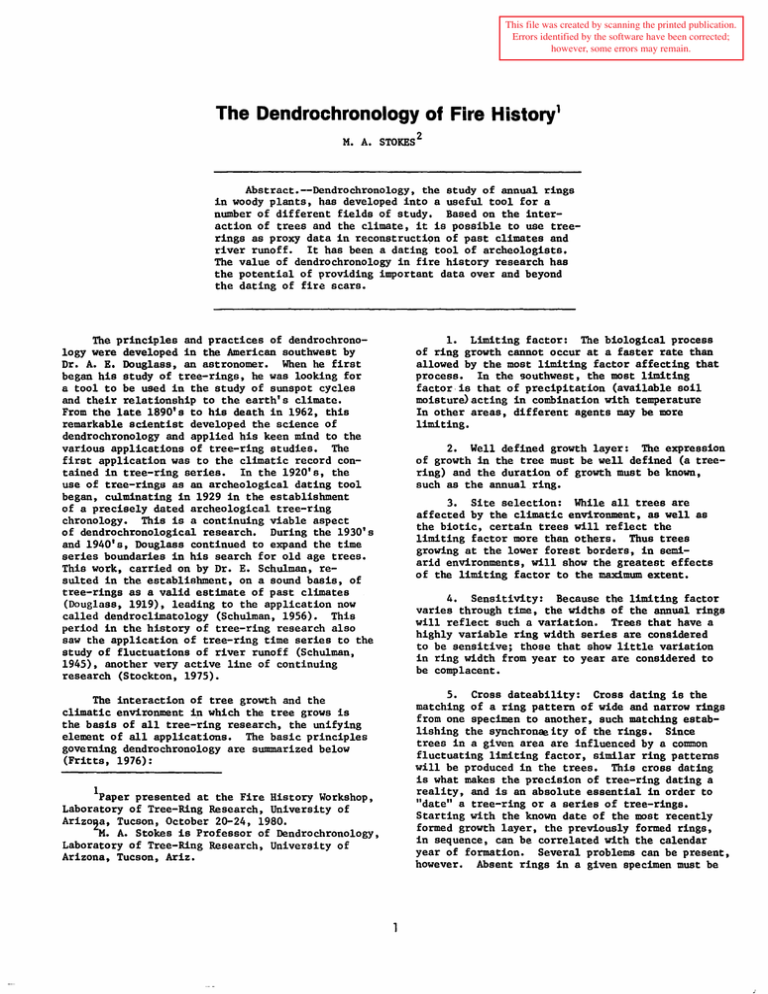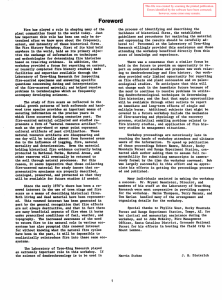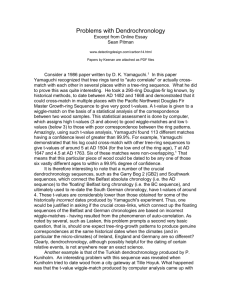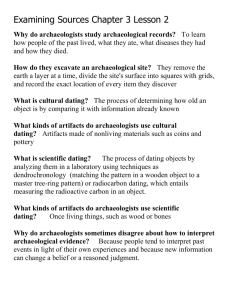The Dendrochronology of Fire History
advertisement

This file was created by scanning the printed publication. Errors identified by the software have been corrected; however, some errors may remain. The Dendrochronology of Fire History1 M. A. STOKES 2 Abstract.--DendroChronology, the study of annual rings in woody plants, bas developed into a useful tool for a number of different fields of study. Based on the interaction of trees and the climate, it is possible to use treerings as proxy data in reconstruction of past climates and river runoff. It has been a dating tool of archeologists. The value of dendrochronology in fire history research has the potential of providing important data over and beyond the dating of fire scars. The principles and practices of dendrochronology were developed in the American southwest by Dr. A. E. Douglass, an astronomer. When he first began his study of tree-rings, he was looking for a tool to be used in the study of sunspot cycles and their relationship to the earth's climate. From the late 1890's to his death in 1962, this remarkable scientist developed the science of dendrochronology and applied his keen mind to the various applications of tree-ring studies. The first application was to the climatic record contained in tree-ring series. In the 1920's, the use of tree-rings as an archeological dating tool began, culminating in 1929 in the establishment of a precisely dated archeological tree-ring chronology. This is a continuing viable aspect of dendrochronological research. During the 1930's and 1940's, Douglass continued to expand the time series boundaries in his search for old age trees. This work, carried on by Dr. E. Schulman, resulted in the establishment, on a sound basis, of tree-rings as a valid estimate of past climates (Douglass, 1919), leading to the application now called dendroclimatology (Schulman, 1956). This period in the history of tree-ring research also saw the application of tree-ring time series to the study of fluctuations of river runoff (Schulman, 1945), another very active line of continuing research (Stockton, 1975). The interaction of tree growth and the climatic environment in which the tree grows is the basis of all tree-ring research, the unifying element of all applications. The basic principles governing dendrochronology are summarized below (Fritts, 1976): 1 Paper presented at the Fire History Workshop, Laboratory of Tree-Ring Research, University of Arizo2a, Tucson, October 2G-24, 1980. M. A. Stokes is Professor of Dendrochronology, Laboratory of Tree-Ring Research, University of Arizona, Tucson, Ariz. 1. Limiting factor: The biological process of ring growth cannot occur at a faster rate than allowed by the most limiting factor affecting that process. In the southwest, the most limiting factor.is that of precipitation (available soil moistur~acting in combination with temperature In other areas, different agents may be more limiting. 2. Well defined growth layer: The expression of growth in the tree must be well defined (a treering) and the duration of growth must be known, such as the annual ring. 3. Site selection: While all trees are affected by the climatic environment, as well as the biotic, certain trees will reflect the limiting factor more than others. Thus trees growing at the lower forest borders, in semiarid environments, will show the greatest effects of the limiting factor to the maximum extent. 4. Sensitivity: Because the limiting factor varies through time, the widths of the annual rings will reflect such a variation. Trees that have a highly variable ring width series are considered to be sensitive; those that show little variation in ring width from year to year are considered to be complacent. 5. Cross dateability: Cross dating is the matching of a ring pattern of wide and narrow rings from one specimen to another, such matching establishing the synchronaeity of the rings. Since trees in a given area are influenced by a common fluctuating limiting factor, similar ring patterns will be produced in the trees. This cross dating is what makes the precision of tree-ring dating a reality, and is an absolute essential in order to "date" a tree-ring or a series of tree-rings. Starting with the known date of the most recently formed growth layer, the previously formed rings, in sequence, can be correlated with the calendar year of formation. Several problems can be present, however. Absent rings in a given specimen must be identified by comparing with ring patterns of other specimens. "False rings", anomalous growth bands which do not represent total growth for any one season, must also be identified in the cross dating procedure. scar. Any discontinuity of the ring series due to "absent rings" can best be worked out along that relatively undistorted radius. Even though the sample may represent a compacent ring series, absent rings along the fire scar face may result in the loss of the precision you seek (see illustration in Fritts, 1976). If working with species of trees that has not been extensively studied by dendrochronological techniques, the absent ring problem is again a real risk (Jordan, 1966). 6. Verification: So that complete confidence may be placed upon the cross dating procedure, a sufficient number of specimens must be studied to insure that all prob~ems have been eliminated from the dated tree-ring series. For those trees with a greater frequency of absent rings, a larger sample size is required. In our research in the Laboratory of Tree-Ring Research, a minimum number of two cores per tree from at least·ten trees which are dateable and sensitive has been established as basic for developing our tree-ring chronologies. Hundreds of chronologies have been develo'ped in the past two decades, and are published in a series of Laboratory p,ublications (Stokes, et al, 1973r D~ew, 1976). These chronologies cover the western United States, ·some ·parts of the midwest, parts of Canada and northern Mexico. ·They constitute a very valuable library of basic data available for many different types of research; including the study of fire history in forest communities. · ' I think we all recognize the importance of sampling both sides of a fire scar. The discrepancy of dates between two sides of a scar can be very great and any frequency estimate based on only one scar radius can be very misleading. The definition of a fire caused scar is something that bothers us here in the TreeRing Laboratory. The criteria we have been using are somewhat uncertain. The presence of charcoal in the wound is the first criterion. The observation of subsequent healing over the area of wounding is the second criterion, and the presence of vertical lines representing the healing from the sides of the scar is the third criterion. But a succession of fires may very well eliminate or obscure evidence of earlier fires and make it difficult to determine whether a "scar" is actual evidence of an earlier and separate fire event. Any of a combination of two of the above criteria is probably accurate, but an element of doubt remains. 4 fourth criterion may be used but we have not quantified this, as yet. In some cases we have observed a band of what appears to be disrupted cells, within the growth ring, at right angles to the scar face. When the origin of the scar is uncertain, this condition may indicate the presence of heat causing either a disruption of cellular tissue or some change in cellular consttuents. The techniques of the actual process of treering dating will not be covered here. The preparation of specimens for dating, skeleton plotting, cross dating, and verifying cross dating are techniques best learned by actual practice (Stokes and Smiley, 1968). As was stated previously, the interaction of tree growth and the climatic environment and its expression of that interaction in the varying ring widths is the basis for dendrochronology, Other factors, however, .are superimposed upon that interaction. One of the factors, the one we are interested in here, is that of fire. The most obvious evidence, of course, is that of the scar resulting from fire. Our immediate interest is to date the fire scars in order to determine some frequency of the fire events, prior to the application of management practices in our forests. Such information is of the utmost importance if we are to incorporate fire as a management tool, and if we wish to determine whether fire is an important part of the total picture of forest ecology. I will cover, briefly, some aspects of dating fire scars and then discuss some further implications. A discrepancy in dates between the two sides of a fire scar has been observ~d. Where the discrepancy between two opposite scars is a difference of one year, the error may very well be in determining in which ring the scars occur. However, do differences of two, three or even four years represent specific fire occurrences? The elminiation of theseslight differences may mean quite a change in the frequency interval obtained. Some caution must be used, until this question is resolved. In summary, all scars which show the curved growth of lateral healing are the most positive indicators of fire events. All others, while they may have certain characteristics which seem to indicate a fire origin, have an element of doubt. Dating a fire scar would seem to be relatively simple: it "dates" according to the ring it is in. The dating of the ring(s) is not done along the two radii of a fire scar, however. To insure the precision of dating, a radius must be selected that is far enough removed from the distortion of ring widths caused by either the fire itself or the subsequent healing process. Therefore, I feel a cross section of the tree stem is necessary for fire scar dating, and the radius selected should be approximately at right angles to the face of the To establish fire frequency, based on dating of fire scars, is a first step in a potentially rewarding line of tree-ring research. If we might, let us speculate a bit. Assuming that fire 2 was part of th~ forest ecosystem in the past, and occurred at some frequency, what more ~nformation may be contained in the tree-rings that would allow you to refine the results now obtained through fire scar dates? Arno and Sneck (1977) pose a question, among others, of what are the effects of past fires on the forests. In growth response studies done in the Laboratory by Fritts and his workers, the climatic parameters of rainfall and temperature are used as independent variables in studying the relationship of tree growth and seasonal changes of the climate. The tree response to fire occurrences may very well be revealed-by using fire history data as another "independent" set of nonclimatic variables to plug into growth response studies_. Using response functi,on analysis, reconstruction of past fire histories, in terms of increased growth or decreased growth, may be possible. Fire, of course, is not independent of climate, and the characteristics of fire are not independent from the characteristics of the forest community it occurs in. Further research will allow us to better define the relationships involved in the tripart system of Douglass, Jt, & 1919. Climatic Cycles and Tree Growth, Vol. 1. carnegie Institute Publication 289. Washington, D. c. Drew, Linda G., Editor. 1976. Tree-Ring Chronologies for Dendroclimatic Analysis. An Expanded Western North American Grid. Chronology Series II, Laboratory of TreeRing Research, University of Arizona, Tucson, Ariz. Fritts, H. c. 1976. Tree-Rings and Climate. Academic: Press, London • Jordan, Carl F. 1966. Fire produced discontinuous growth rings in oak. Bulletin of the Torrey Botanic~~~. Vol._93, No~ 2, pp. _114~116. Schulman, E. 1956. Dendroclimatic Change in Semi-arid America. University of Arizona Press, Tucson, Ariz. --~~~~~ 1945. Tree-Ring Hydrology of the Colorado River Basin. University of Arizona Bulletin, Vol. 16, No. 4. Tucson, Ariz. Stockton, c. w. 1975. Long term streamflow records reconstructed from tree-rings. Papers of the Labor~tory of Tree-Ring Research, No. S, University of Arizona Press, Tucson, Ariz. Climate Tree growth Fire Stokes, M. A., Linda G. Drew and c. W. Stockton, Editors. 1973. Tree-Ring Chronologies of Western America. Vol. 1. Selected Tree-Ring Stations. Chronology Series 1, Laboratory of Tree-Ring Research, University of Arizona, Tucson, Ariz. LITERATURE CITED Arno, S. F., and K. M. Sneck. 1977. A method of determin ing fire history in coniferous forests of the mountain west. U. S. Department of Agriculture Forest Service General Technical Report IVT-42. Stokes, M. A. and T. L. Smiley. 1968. Introduction to Tree-Ring Dating. University of Chicago Press, Chicago, Ill. 3







